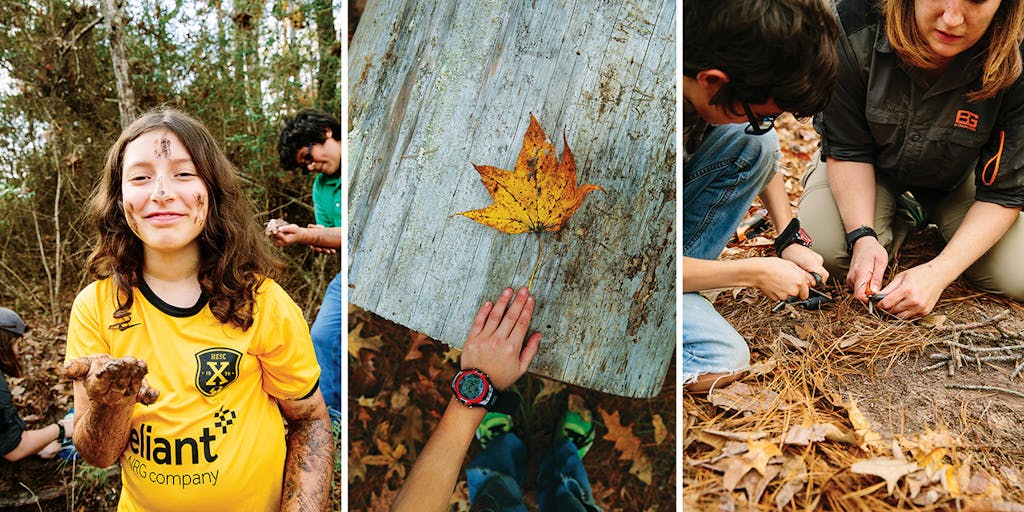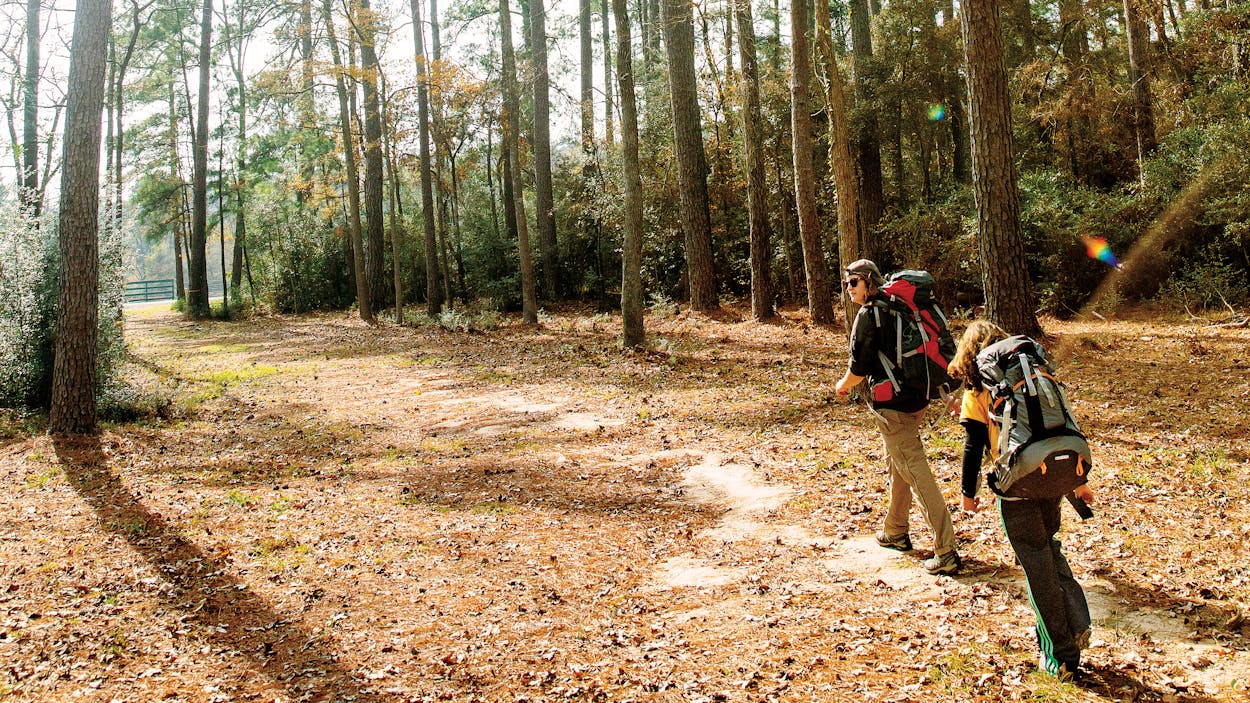A funny thing happened on our way to survival school. My nine-year-old daughter, Ursula, and I were packing up our gear to head to an intensive 24-hour Bear Grylls Survival Academy course in the Piney Woods when I got word that all the other families that had signed up for the kid-friendly wilderness workshop had canceled because of the threat of stormy weather. The director of YMCA Camp Cullen, the 530-acre compound on the shores of Lake Livingston where the recurring outdoor skills course would be held, had called to ask if we could wait a week so that a fresh batch of participants might be recruited. Sure, I said, but since when did would-be survivalists worry about getting wet?
Being a weather wimp is no crime, but the abrupt dropouts underscored the very issue that had made me want to take my fourth grader to survival school in the first place: amid a tsunami of screen time and social networking, not to mention everyday distractions like organized sports and endless homework, our youngest Texans are losing their connection to the great outdoors. Fewer kids, it seems, are reconnoitering rolling fields of wildflowers in the Hill Country, roaming the rugged Big Bend backcountry, casting for crappie (and keeping an eye out for gators) in Caddo Lake’s moss-draped sloughs, or sorting seashells along the coast. Not only are they missing out on the stunning landscapes that define our natural heritage, but they may not even get the chance to enjoy them as adults if the constituency for the protection and stewardship of our special places continues to be eroded.
It’s not exactly a new problem. In his best-selling 2005 book, Last Child in the Woods, journalist Richard Louv outlined the negative effects of what he called “nature deficit disorder.” Studies have shown that young and old alike pay a high price for being too indoorsy and too attached to their devices, a cultural trend that has coincided with higher rates of obesity, attention disorders, and depression.
In Texas, shifting demographics are largely to blame for this detachment from nature. We’re predominantly urban now and our cities have swelled with newcomers; fewer and fewer Texans have roots that trace back to the ranching and farming families that once quite literally shaped our state as they worked the land. And then there’s our overtaxed educational system. According to the National Center for Educational Statistics, Texas kids spend 7.17 hours per day in a classroom, longer than students in any other state.
In 2009, using Louv’s research as a rallying cry, Carter Smith, the executive director of Texas Parks and Wildlife, worked with a team of educators, legislators, and nonprofit leaders to form Texas Children in Nature, a private-public network of more than three hundred organizations that aims to make it easier for families to find al fresco activities. “Getting kids outdoors is a necessity, not a luxury,” says Smith, who speaks as both a father and a seventh-generation Texan. “With growing competition for discretionary leisure time, we really need to find ways for our kids to enjoy nature.” So how do we re-wild the next generation?
As an outdoorsy dad, I simply asked myself, “What would Bear Grylls do?”
Anybody who has watched the jocular 42-year-old risk his neck and eat disgusting things on his hit shows, like Man vs. Wild and Running Wild With Bear Grylls, knows that the former British Special Forces soldier—and father of three sons—has a few ideas about how we can best reconnect with nature. In the Texas episode of Man vs. Wild that I watched with Ursula, Grylls parachutes into Big Bend, runs through the desert, then kills and eats a rattlesnake. To follow in his literal footsteps might be folly, but attending one of the family-friendly Survival Academy courses that he has created would surely further stoke our thirst for adventure.
Although Grylls himself wouldn’t be on hand for the course in East Texas, Ursula’s enthusiasm was undeniable when I asked her if she’d like to go. I wasn’t surprised. I am fortunate to have a child who complains when I go fishing without her, who eats dried crickets from the vending machine at the Houston Museum of Natural Science, and who writes letters to Hershey’s and other chocolatiers about the threats that palm oil plantations pose to orangutan habitats in Borneo. For the past three years, we have used her birthday campouts to introduce her BFFs to the joys of sleeping in a tent, exploring the woods, and roasting marshmallows. But even though Ursula is a natural in nature, I wanted to further bolster her outdoor skills so that one day she’d be able to get along in the wilderness without me.
So the week before Christmas, under spotty skies, we drove a hundred miles north of Houston to the woodsy YMCA Camp Cullen to attend the rescheduled survival camp. The previous weekend’s rain had passed, but now a cold front was predicted. We were joined by a camo-clad father-and-son team from nearby Spring as well as Camp Cullen’s maintenance manager and his two sons. Since Ursula was the only girl, I was glad to learn that two young women, Ashley Montgomery and Desiree Ayala, would be our instructors. Over the next 24 hours, they would teach us how to build basic shelters, start a fire using flint, and navigate using only the sun as our compass.

Montgomery and Ayala handed out canteens and Bear Grylls–branded bug-out bags. Into these fancy loaner backpacks we each stuffed a change of clothes and a water-resistant sleeping bag designed to withstand freezing temperatures. The grown-ups were also provided with flint and ten-inch serrated Gerber knives that Grylls had helped design. I noted, with mild alarm, that the only food we were given was some peanut-butter crackers, so I threw in a few energy bars that I’d brought along too. Once loaded up, we departed the YMCA compound, followed our leaders across the highway, and set off into the woods where we would spend the night.
One of the biggest obstacles to getting kids outdoors may be their parents’ irrational notion that being out in nature is inherently dangerous, particularly once the sun goes down. In his book, Louv writes, “Fear is the most potent force that prevents parents from allowing their children to enjoy the freedoms they themselves enjoyed when they were young.” Meanwhile, over in Europe, the creation of “wild” playgrounds, where kids can light fires, wrestle in the mud, and otherwise explore without much parental interference, has been the catalyst for a vibrant back-to-nature movement that stands in stark contrast to the helicopter style of parenting so prevalent in the States. Advocates say such rugged outdoor experiences build self-confidence and bravery, and it makes me wonder why so many Texans, despite their gritty frontier heritage, struggle to recognize this forest through the trees.
Given that I’d made fun of the other parents for being scared off by the previous weekend’s rainout, you would think I had forfeited my right to worry about the weather. But I wasn’t running this show, we did not have a tent, and now it looked like trouble was brewing. After our warm afternoon hike, an icy blue norther started kicking up chop on Lake Livingston just as Ursula and I were putting the finishing touches on the debris hut we had constructed out of branches and leaves. Our structure was a wreck compared with the marvelously engineered lean-to made by Camp Cullen’s maintenance manager and his sons, but as I peered through the latticework of yaupon and longleaf pine boughs, I felt certain that, barring a tornado, we would be safe and dry, if not exactly toasty. In a collective effort, we sparked small piles of tinder to get a fire going. Meanwhile, our leaders explained to us the survivalist’s Law of Threes: “Three weeks without food, three days without water, three hours without shelter, three minutes without air, three seconds without positive mental attitude; without any or all of these, you will not survive.” Roger that. Then, after teaching us about snares, they delivered us a dead rabbit. The kids looked on as the animal—which wasn’t actually wild-caught—was butchered and grilled.
As night fell, so did the temperature, which dropped from 70 to 30 degrees. In our hovel, which looked like a beaver den on dry land, Ursula pressed up against my chest. At dawn, she sat up and declared, “Dad, this is the best crazy thing we’ve ever done.” Though she was still tired, cold, and dirty, she shouldered her pack and fell in line with the boys without so much as a glance back at dear old dad. After a single night, she seemed more determined than ever. I was delighted my gamble had paid off.







